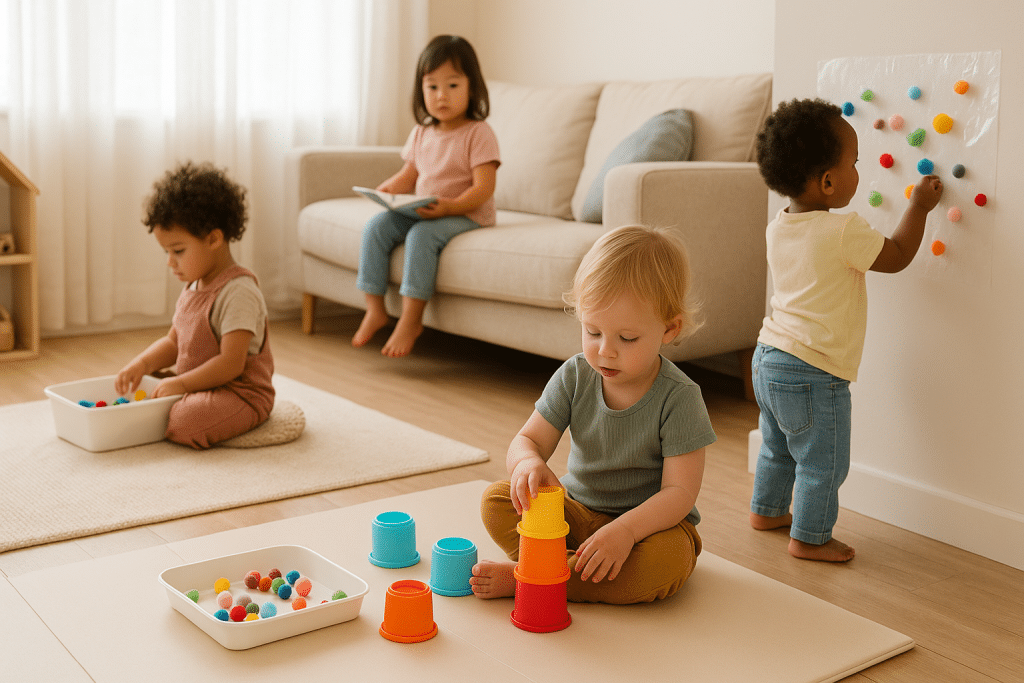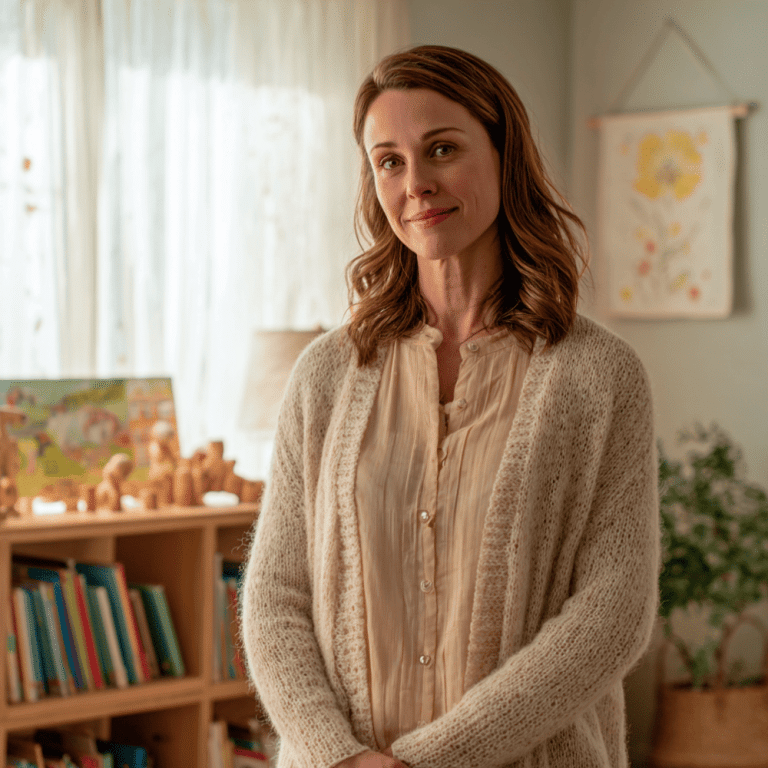Two-year-olds are full of energy, and their curiosity seems to have no limits. They love testing, touching, and trying new things every day.
This makes the toddler stage fun but also a little overwhelming at times. Parents often face the challenge of keeping their little ones engaged indoors without turning to screens.
The good news is that there are plenty of simple and playful activities that can keep a child busy while also supporting their growth.
I’ve gathered easy ideas that you can do at home with little setup and no stress. These activities cover learning, movement, creativity, and pretend play.
You’ll also find a daily schedule that shows how to fit these activities into a toddler’s routine. Let’s start with quick and low-prep activities.
Learning Activities for 2-Year-Olds
Toddlers learn best through play. At this age, activities should be simple, fun, and easy to set up. Below are different categories of activities that help with learning, creativity, movement, and social skills.
Quick & Low-Prep Indoor Activities
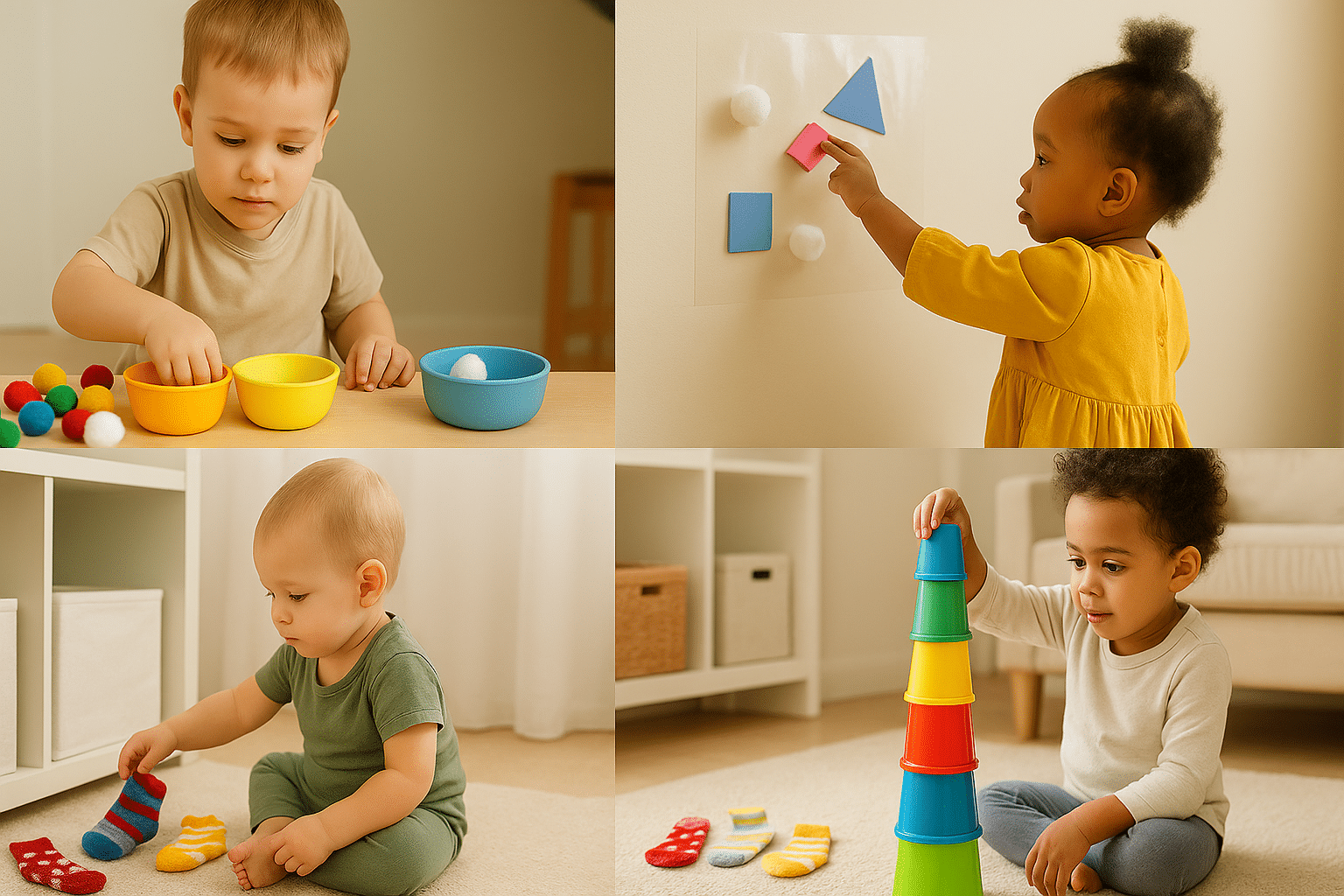
These activities take only minutes to set up and use things you already have at home. They keep toddlers busy indoors while helping them learn new skills.
1. Pom-Pom Sorting
Give toddlers pom-poms and bowls to sort by color. It’s easy, mess-free, and improves focus. This activity also builds color recognition and strengthens the small hand muscles needed for writing later.
2. Card Slot Drop
Cut a slit in a container lid. Toddlers drop cards through the slot, staying neat while practicing patience. It encourages focus, strengthens hand-eye coordination, and offers engaging, repetitive play.
3. Sticky Wall
Tape contact paper to the wall, sticky side out. Provide cotton balls or shapes to press. This activity sparks creativity, builds fine motor control, and adds fun sensory learning.
4. Magnetic Letters on Fridge
Place magnetic letters at toddler height. Kids can move, stick, and pull them off. This clean activity introduces early literacy, builds curiosity, and encourages playful, hands-on learning with words.
5. Toy Rotation Box
Hide half of the toddler’s toys and rotate weekly. This simple method reduces clutter, feels new each time, and keeps kids engaged while encouraging longer, independent play sessions at home.
6. Sock Matching Game
Mix up socks and ask toddlers to find pairs. It’s quick, tidy, and fun. The activity sharpens focus, builds sorting skills, and lets kids help with simple household chores.
7. Sticker Play
Give toddlers stickers and paper to decorate. It’s mess-free, builds finger strength, and encourages decision-making. This simple craft also sparks creativity and supports independent play while keeping children entertained.
8. Cup Stacking
Provide plastic cups to stack into towers and knock down. This activity is easy, repeatable, and fun. It teaches patience, problem-solving, and balance while keeping toddlers happily engaged indoors.
9. Shape Hunt
Cut paper shapes and hide them around the room. Ask toddlers to find and name each one. The game improves recognition, builds memory skills, and keeps play active indoors.
10. Sorting Toys by Size
Give toddlers toys in different sizes to group into “big” and “small.” The activity is quick, clean, and builds early math skills, observation, and logical thinking that toddlers enjoy.
These activities give parents quick, low-prep options to keep toddlers learning and entertained indoors.
Sensory Play at Home
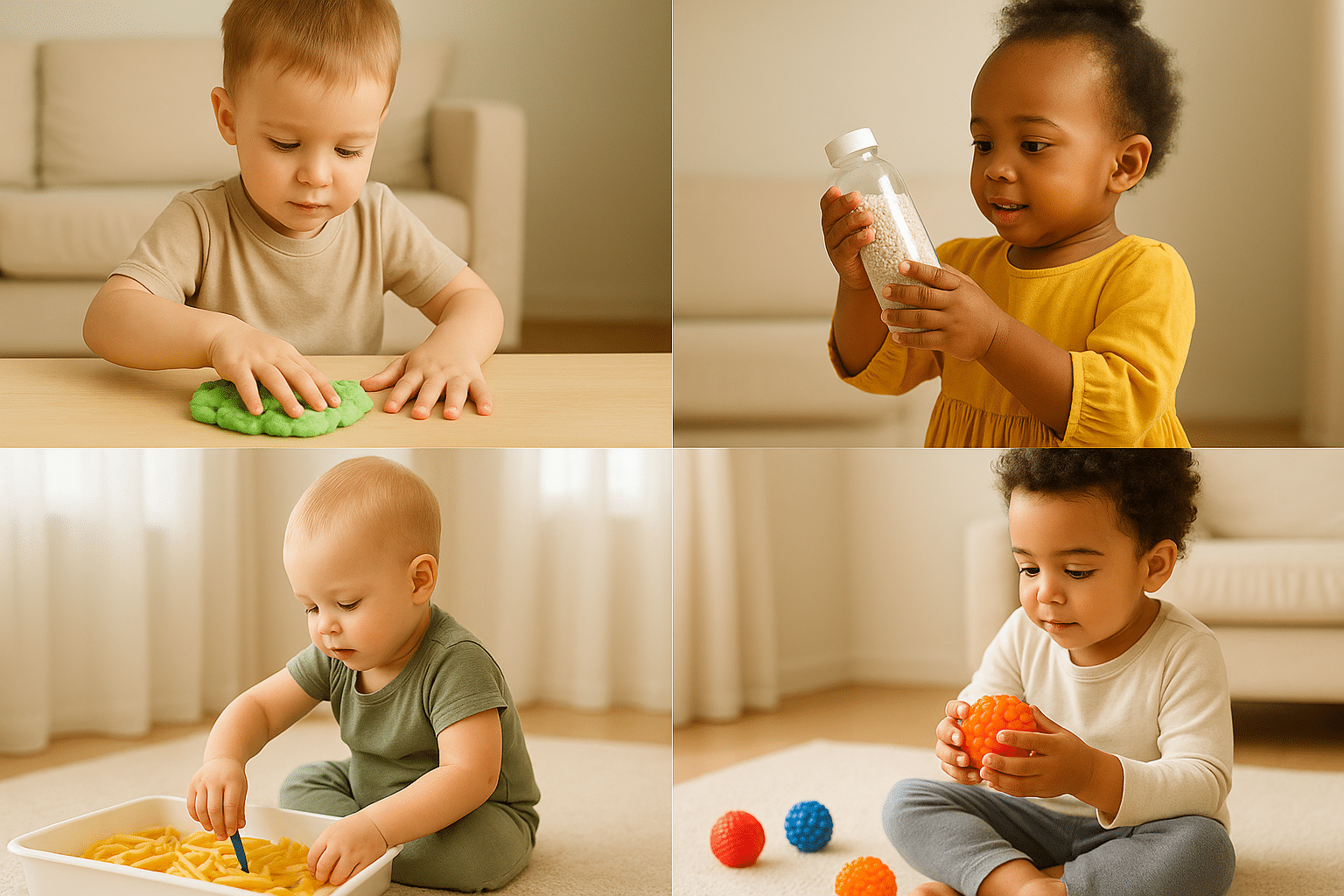
Sensory activities let toddlers learn through touch, sight, and sound. These simple ideas use items you already have at home. They keep children calm, focused, and curious while supporting development.
11. Playdough Fun
Give toddlers non-toxic playdough to roll, press, or shape. The soft texture strengthens fingers, sparks creativity, and keeps them calm. It’s low-mess and can be repeated daily with new ideas.
12. Rice Sensory Bin
Fill a shallow container with rice and add spoons or small toys. Toddlers scoop, pour, and bury items, improving hand control, encouraging pretend play, and enjoying a calming, repetitive sensory experience.
13. Water and Cups
Set out cups, spoons, and a small jug of water. Toddlers pour and transfer, practicing focus, coordination, and patience. This low-cost activity fascinates children who love understanding water movement.
14. Frozen Toy Rescue
Freeze small toys in ice cubes or a container. Give toddlers safe tools to “rescue” them. It teaches cause and effect, problem-solving, and excites with the surprise of hidden toys.
15. Texture Basket
Fill a basket with fabrics, blocks, or sponges. Let toddlers understand each texture. This activity builds sensory awareness, teaches words like smooth or rough, and sparks curiosity using everyday household items.
16. Bubble Wrap Play
Place bubble wrap on the floor for stomping or pressing. Toddlers enjoy the popping sound and texture, which keeps them engaged. It’s safe, fun, and a great sensory indoor option.
17. Pasta Play
Offer cooked or uncooked pasta with bowls or pipe cleaners. Toddlers scoop, sort, or thread pieces, learning textures while building hand strength. It’s creative, budget-friendly, and keeps children engaged indoors.
18. Shaving Cream Play
Spread shaving cream on a tray and let toddlers draw patterns. The soft, squishy texture improves creativity, provides messy sensory fun, and can be wiped clean easily for reuse.
19. Sound Bottles
Fill plastic bottles with rice, beans, or beads. Toddlers shake them to learn sounds. This activity builds focus, rhythm, and curiosity while creating safe, reusable sensory toys for everyday play.
20. Sensory Ball Play
Give toddlers balls with different textures like spiky, smooth, or squishy. They roll, squeeze, or toss them, building sensory awareness, coordination, and focus through simple indoor play.
These sensory activities are calming, easy, and fun, giving toddlers safe ways to understand their world while staying entertained at home.
Arts & Crafts for Toddlers
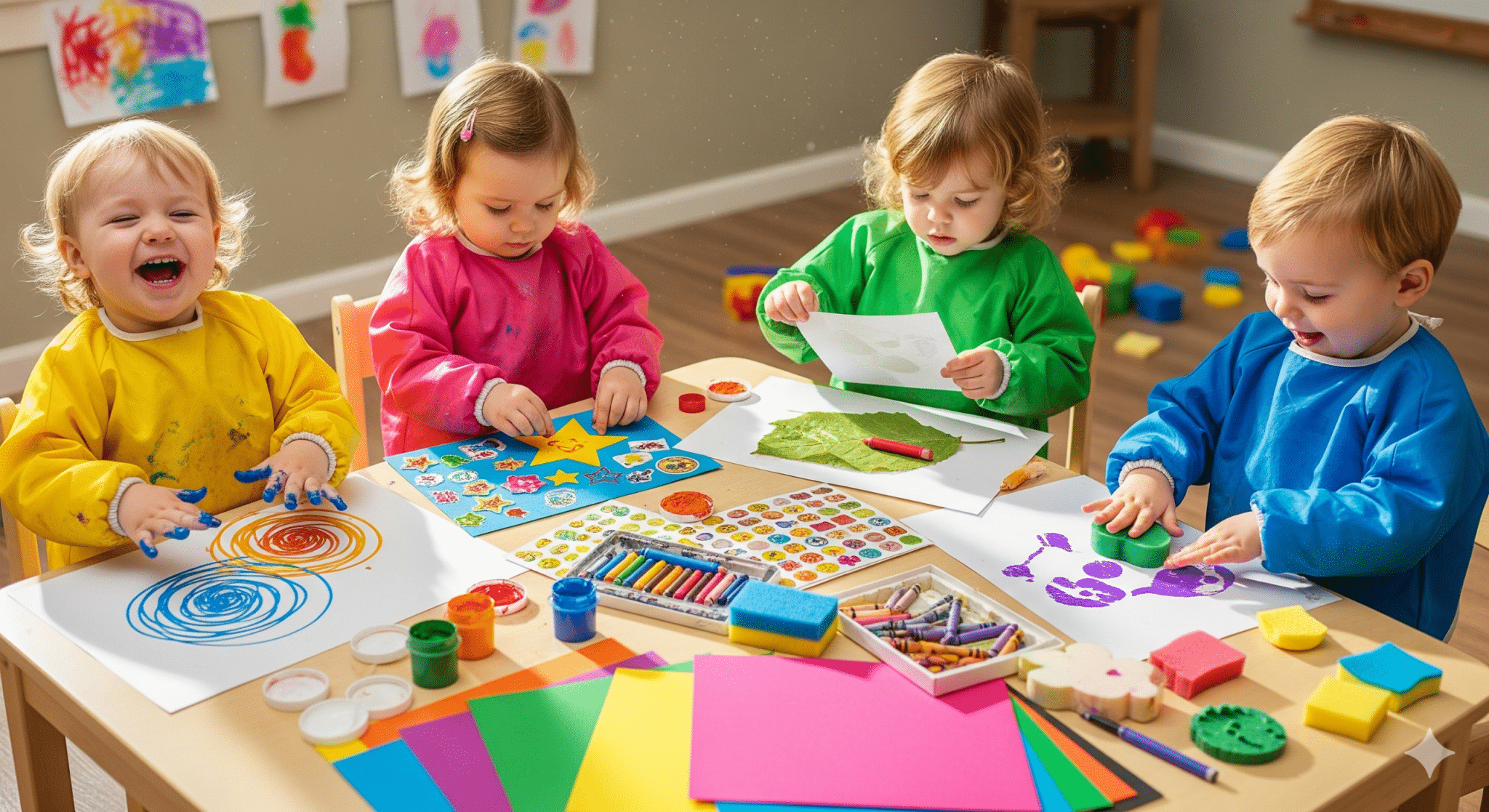
Arts and crafts give toddlers a creative way to express themselves. Using safe and washable supplies keeps things fun while avoiding stress. These ideas build creativity, support color recognition, and encourage bonding.
21. Finger Painting
Give toddlers washable paints and paper. Let them dip fingers to make shapes or patterns. It’s safe, encourages creativity, teaches color mixing, and allows free expression through direct, hands-on play.
22. Sticker Art
Provide colorful stickers and paper. Toddlers arrange stickers into their own designs. This neat, simple activity develops fine motor skills, encourages decision-making, and supports independence while giving space for creative understanding.
23. Contact Paper Collage
Tape contact paper to the wall, sticky side out. Toddlers press cutouts, fabric, or leaves onto it. This activity sparks creativity, teaches textures, and strengthens coordination through simple, hands-on experience.
24. Sponge Stamping
Cut sponges into shapes, dip them in washable paint, and stamp them onto paper. This low-cost craft builds patterns, hand control, and creativity while keeping toddlers entertained through fun, repetitive play.
25. Crayon Rubbings
Place textured items under paper and rub crayons across. Shapes appear like magic, sparking curiosity. This activity teaches textures, sharpens observation, and makes creativity fun using everyday household materials.
26. Paper Tearing Art
Give toddlers colored paper to tear into pieces and glue onto a sheet. This activity builds hand strength, teaches color use, sparks creativity, and adds sensory fun to crafting.
27. Dot Markers
Hand toddlers washable dot markers to stamp colorful designs. The activity builds grip strength, improves focus, and introduces color recognition while staying quick, cheerful, and easy to clean afterward.
28. Nature Painting
Collect leaves or pinecones and dip them in paint for printing. This activity brings nature indoors, teaches textures and creativity, while letting toddlers remember unique shapes in art.
29. Collage with Safe Glue
Provide safe glue sticks and materials like fabric, paper, or cotton balls. Toddlers create collages freely, strengthening fine motor skills, improving creativity, and learning design through hands-on experience.
30. Homemade Stamps
Use potatoes or foam shapes as stamps. Dip them in paint and press on paper. This craft teaches cause and effect, builds coordination, and introduces playful patterns for toddlers.
These craft ideas are safe, easy, and fun ways to help toddlers develop creativity while learning important early skills.
Indoor Gross Motor Activities
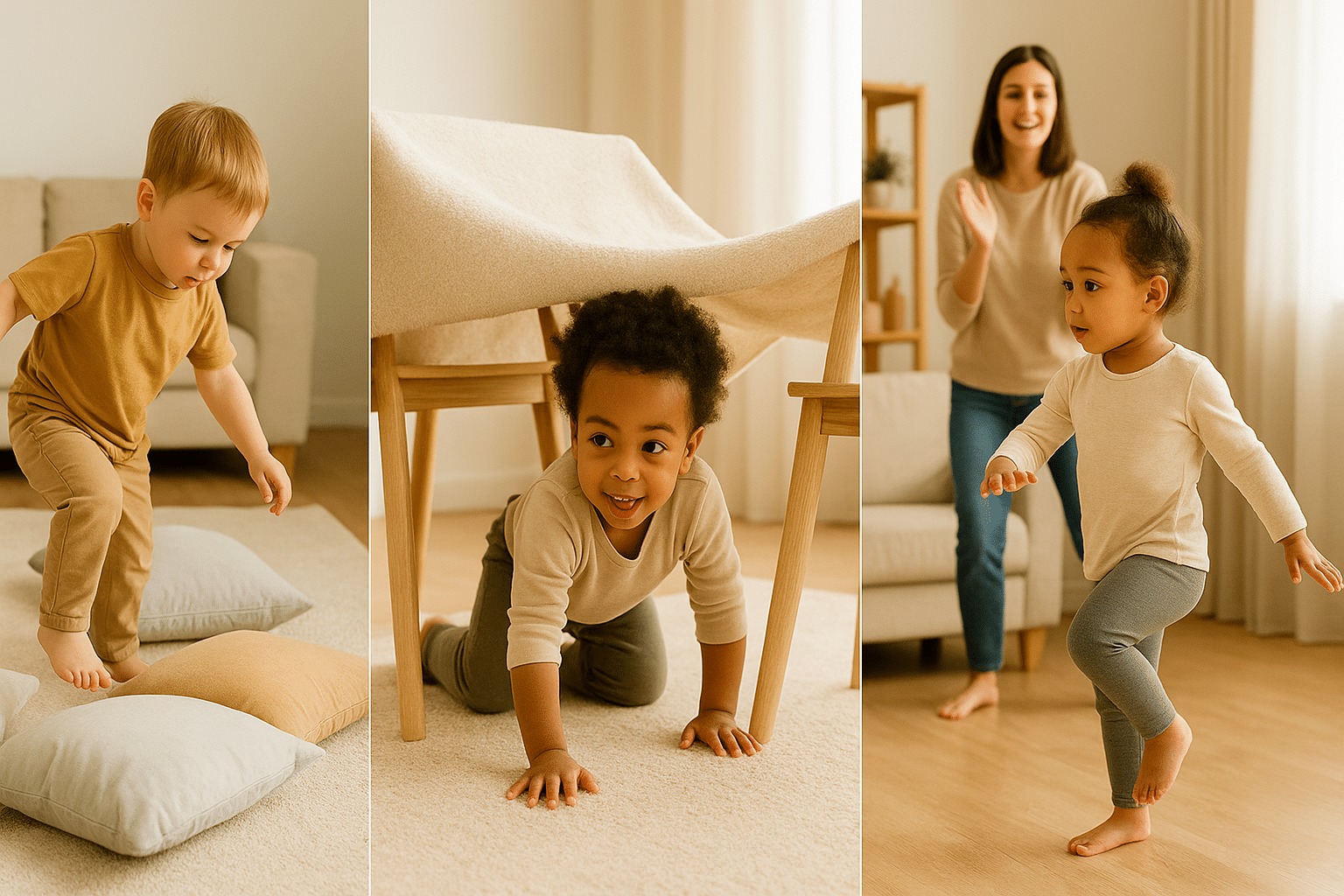
Toddlers need ways to move and burn energy indoors. These simple activities use little space and no special equipment. They build balance, coordination, and confidence while keeping playtime fun.
31. Pillow Obstacle Course
Arrange pillows on the floor for climbing, crawling, or jumping. This safe, simple setup strengthens muscles, builds balance, and turns an ordinary room into an active play zone toddlers love.
32. Freeze Dance
Play music and let toddlers dance. Pause and ask them to freeze in place. This stop-and-go game burns energy, teaches self-control, builds rhythm, and creates fun bonding moments.
33. Balloon Toss
Blow up a balloon and toss it back and forth. Encourage toddlers to keep it from touching the ground. This playful game builds coordination, tracking skills, and safe indoor fun.
34. Tunnel Crawl
Line up chairs and cover with a blanket to make a tunnel. Ask toddlers to crawl through. It sparks adventure, builds motor strength, improves coordination, and can become a fort.
35. Simon Says
Play Simon Says with simple actions like jumping, clapping, or spinning. Toddlers enjoy copying commands while improving listening skills, coordination, and burning energy. It’s a quick game to play anywhere.
36. Animal Walks
Ask toddlers to crawl like bears, hop like frogs, or waddle like ducks. This activity builds strength, coordination, and flexibility while mixing pretend play with fun movement indoors.
37. Rolling Races
Clear the space and have toddlers roll across the floor like logs. Join them for extra fun. This activity develops body awareness, provides safe exercise, and fills playtime with giggles.
38. Hallway Bowling
Set up plastic cups or bottles as pins. Give toddlers a soft ball to knock them down. Bowling indoors builds coordination, aim, and excitement with quick resets for replay.
These activities keep toddlers active, coordinated, and happy indoors, even when space is limited.
Imaginative Play & Pretend Games
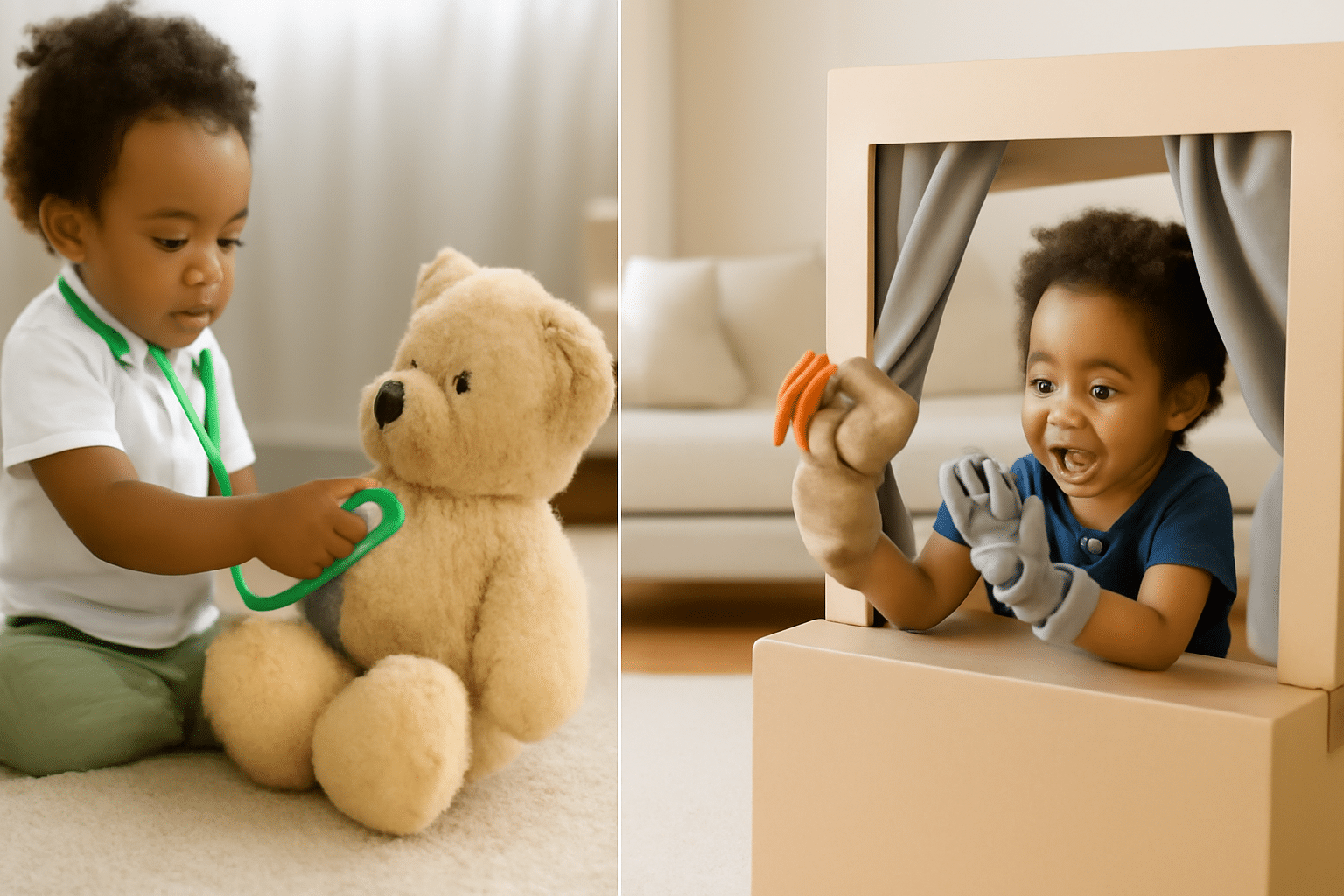
Pretend play helps toddlers build language skills, understand feelings, and develop creativity. With simple props, children can create whole new worlds right at home.
39. Play Kitchen
Set up a toy kitchen or real pots and spoons. Toddlers “cook” meals, copy routines, and share with family. This sparks imagination, builds vocabulary, and teaches important social development skills.
40. Pretend Doctor
Give toddlers a toy stethoscope or spoon as one. Let them check stuffed animals or family members. This play builds empathy, develops language, and makes doctor visits feel less scary.
41. Stuffed Animal Picnic
Lay out a blanket with toy food and stuffed animals. Toddlers pretend to feed and share, building imagination, turn-taking skills, and social-emotional growth through familiar mealtime routines.
42. Fort-Building
Use chairs, pillows, and blankets to build a fort. Toddlers pretend it’s a cave or house. This activity sparks creativity, teaches problem-solving, and creates a cozy reading or play space.
43. Dress-Up Corner
Collect scarves, hats, or costumes for a dress-up basket. Toddlers act as superheroes, parents, or characters. This play supports self-expression, builds vocabulary, and encourages storytelling in creative ways.
44. Pretend Store
Set up a shop with toy food and play money. Take turns as shopkeeper and customer. This role-play builds counting, language, problem-solving, and teaches toddlers how to share.
45. Puppet Play
Use sock puppets or store-bought ones for storytelling. Toddlers act out simple stories, build confidence, and express feelings. Puppet play strengthens language skills and encourages parent-child bonding.
These pretend play ideas use everyday items to spark creativity, teach social skills, and keep toddlers engaged in meaningful play.
Learning & Language Activities
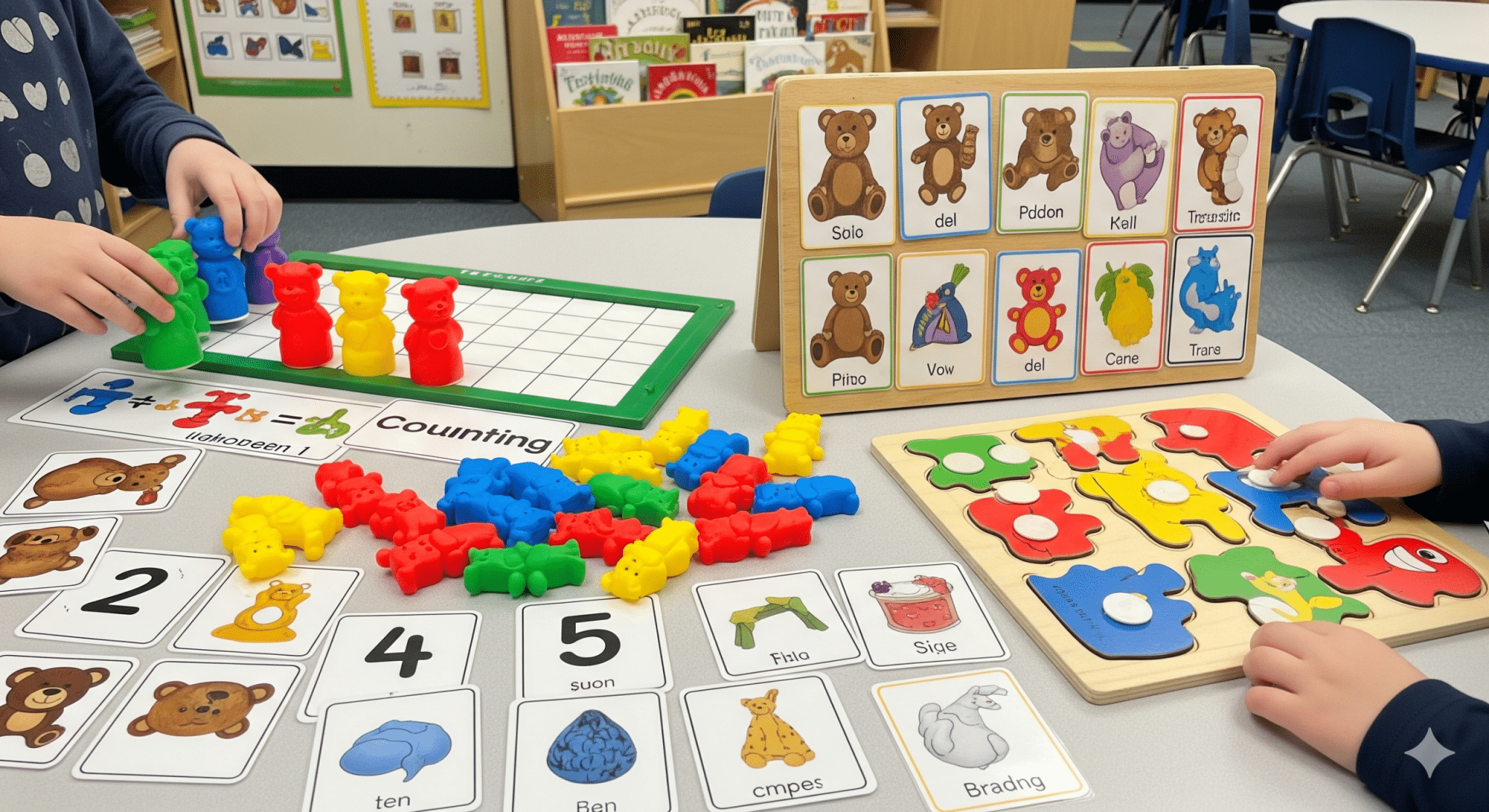
Learning doesn’t need to be formal at this age. Simple, playful activities help toddlers build vocabulary, practice problem-solving, and strengthen focus while keeping them engaged at home.
46. Storytime Corner
Set up a cozy corner with books and pillows. Read aloud and let toddlers turn pages. Storytime builds vocabulary, sparks imagination, teaches focus, and encourages bonding through daily reading.
47. Counting Bears
Give toddlers small counting bears or toys. Ask them to sort or count groups. This playful math activity develops early number sense, teaches patterns, builds problem-solving, and increases confidence.
48. Simple Puzzles
Offer wooden puzzles or shape sorters. Fitting pieces together strengthens hand-eye coordination, builds patience, and teaches problem-solving. Completing puzzles gives toddlers focus and a sense of achievement while learning.
49. Singing Action Songs
Sing songs like “Itsy Bitsy Spider” or “Head, Shoulders, Knees, and Toes.” Encourage copying movements. This fun activity builds memory, vocabulary, body awareness, and coordination through music and play.
50. Name Recognition Games
Write your toddler’s name on paper or use magnetic letters. Point and say each letter. This game introduces letter recognition, vocabulary, and helps children feel proud of learning their name.
51. Matching Picture Cards
Create cards with animals, shapes, or objects. Ask toddlers to match pairs or find the right picture. This activity builds memory, attention, vocabulary, and concentration while encouraging early achievement.
52. Object Naming Hunt
Hide everyday items like a spoon or ball. Ask toddlers to find each as you name it. This game teaches word recognition, sharpens listening, and makes language practice active.
These activities turn learning into playful, everyday moments that build language, focus, and problem-solving skills toddlers will use daily.
Sample Daily Schedule for a 2-Year-Old
A simple routine helps toddlers stay balanced and calm. This schedule mixes play, learning, and rest into a smooth day.
| Time of Day | Activities | Purpose |
|---|---|---|
| Morning | Sensory play (water bin, rice, playdough), snack, storytime | Focus, calm start, structure |
| Midday | Movement activity (freeze dance, balloon toss, obstacle course), lunch, nap | Energy use, coordination, rest |
| Afternoon | Arts & crafts (finger painting, sponge stamping), pretend play (picnic, dress-up), quiet reading | Creativity, imagination, and relaxation |
| Evening | Independent play (puzzles, blocks, stickers), family time (meal, short walk, games) | Confidence, bonding, bedtime |
This routine can be adjusted to fit your toddler’s energy and family schedule while keeping the day balanced and fun.
Tips for Parents
Simple adjustments can make playtime smoother and more enjoyable for both kids and parents. These tips help keep little ones engaged, balanced, and growing with ease.
- Keep activities short: 10–20 minutes is enough for most toddlers.
- Rotate toys and activities: Store some away and reintroduce weekly to keep interest fresh.
- Mix calm and active play: Balance movement games with quiet time, like reading or puzzles.
- Encourage independent play: Start with a few minutes while nearby, then slowly increase time.
Conclusion
Keeping a toddler entertained doesn’t need to be complicated. These simple activities for 2-year-old children make playtime fun while supporting their learning and growth.
From quick indoor games to creative crafts and pretend play, each idea gives parents easy ways to fill the day with purpose.
A flexible daily schedule also helps balance movement, calm time, and independent play, making life smoother for both parent and child.
Remember, every toddler is different, so try a variety of activities and see which ones your child enjoys most.
For more ideas and inspiration, read my other blogs where you’ll find even more practical tips to support your little one’s development.
Frequently Asked Questions
How long should a toddler spend on one activity?
A toddler spends 10–20 minutes on one activity. Switch when interest drops.
Are screens okay during the day?
Screens can be okay during the day, but they should be used in short, intentional bursts rather than as the main activity. Prioritize hands-on play.
What if the attention span is very short?
Keep the activity setups tiny, offer choices of two, and switch quickly.


